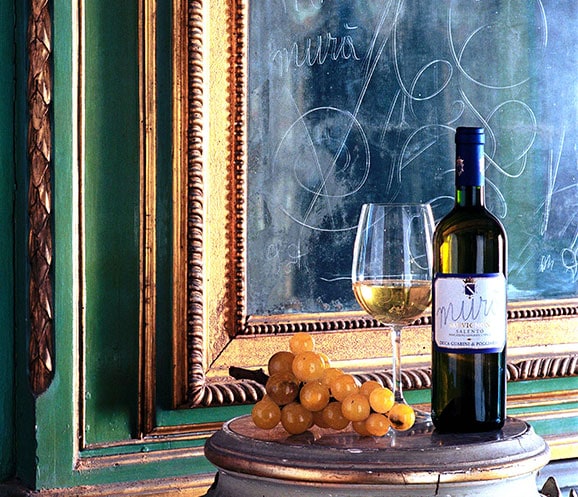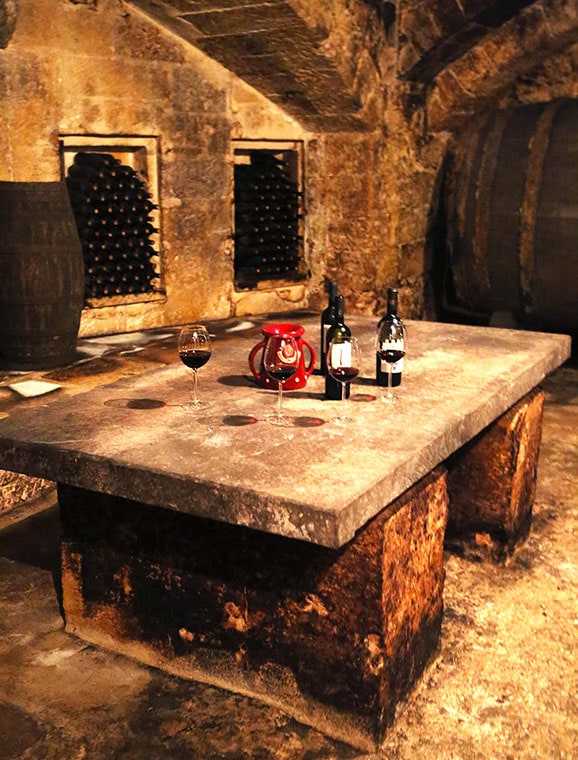
Behind a glass of wine there is a world of human experiences, within ours , there are those of a family that has a long history and a strong bond with the territory.
Imagine a palace dating back to the eighteenth century, with a “secret” garden, fragrant with the scents of citrus fruit and grapes, under which there is a hypogeum dug out of the stone, already used in the sixteenth century as an oil mill with seven presses and transformed into a ‘barricaia’, a cellar where the wines are now left to settle in small and large oak casks and where the bottles of the different vintages are stored.
The soft light creates an almost mystic atmosphere and if you go for a visit, the Guarinis, offering a good glass of wine, will tell you that for them to be winemakers means having an inheritance to protect, land to cultivate, culture to share.
We are a Norman family arrived in Apulia in the Eleventh century and our knights have contributed, with the Hauteville, to the conquest and the formation of the Kingdom of Sicily.
Ruggero Guarini is the first in living memory. In 1065, under the Count Goffredo D’Hauteville, he brilliantly defended Lecce by the attack of Bohemond d’Hauteville, first son of Robert Guiscard, forcing him to free the town from the siege. Once the covenants changed, he departed with Bohemond to the first Crusade in the Holy Land and came back victorious in 1106. After Ruggero, many representatives of our family had the honor to cover important roles in the Norman, Swabian, Angevin, Aragonese and Bourbons realms. There were many landowners, warriors, knights, admirals, clergymen, letters, legal, political and poets. There are memories of Accardo Earl of Valesio, son of Robert, already owner of a vineyard in 1114 and among other stories, that of St. Francis of Assisi in 1219, who returning from his pilgrimage to Jerusalem, arrived in Lecce and two Guarini brothers donated the Saint “few houses for him and his religious”, as reported by the inscription still legible in the place, where, afterwards, was erected a Church entitled to San Francesco della Scarpa.

Under King Charles I of Anjou,in 1250, Pasquale was Consul of the Sea in Brindisi and also admiral of the royal galleys of that city; another Pasquale was Baron of San Cesario Caprarica, guardian of Mary of Enghien, Countess of Lecce and Queen of Naples, whereas his son Augustine, who married Andronica Paleologo in 1420, in 1455 received, by the son of Maria d’Enghien Gian Antonio Orsini, Prince of Taranto, the fief of Poggiardo. And then there is the beautiful story of Father Ignazio Guarini, a Jesuit, who in 1733 was sent by Pope Clement XI in Dresden to teach the Catholic religion at the court of Frederick Augustus II, King of Poland and Elector of Saxony: he taught French to Princess Maria Josefa, who was intended as a bride to the dauphin of France, Louis Ferdinand and was mother of Louis XVI.
Ignazio also taught Italian to Princess Maria Amalia, who became Queen of Naples, wife of Charles III of Spain and King of Naples. It is said that during his stay at court he was shot in an arm, probably in an attack hatched by the Queen Mother, a fierce Lutheran, who didn’t tolerate her son conversion. Also because of her contacts at the Vatican, the art of the mosaic was introduced in the Polish court, a secret prerogative of the Opera di San Pietro, a small thriller. Thanks to his familiarity with the King his nephew Federico Guarini, son of the Duke of Poggiardo Ottaviano, was appointed Captain of the Infantry regiment of the Earl of Bhrül in 1742. Ignazio died in Dresden, just before his imminent appointment as Cardinal. Over the centuries, more than 100 families were related with ours, we administered more than 50 feuds in Terra d’Otranto and many famous people have been guests of our family, like Joseph Bonaparte in 1807 and Joachim Murat, King of Naples, guest in 1813 in the Palace of Lecce, where he left his signature engraved on a mirror, signature that is reproduced on our wine dedicated to him, Murà.

